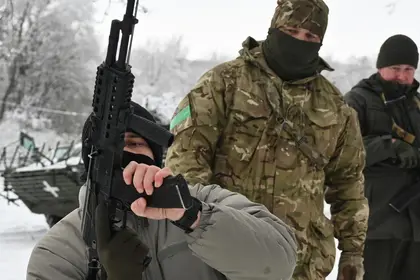A national security policy paper newly-released by Estonia’s Defence Ministry said Ukraine and its allies would inevitably defeat Russia provided its supporters stay united, and that the Ukrainian military is currently killing and injuring more than ten thousand Russian soldiers each month.
The discussion paper Setting Transatlantic Defence up for Success: A Military Strategy for Ukraine’s Victory and Russia’s Defeat was published on Thursday. It said the critical factor in what had become a war of attrition was the ability of the West to commit sufficient military-industrial resources to allow Ukraine to defend its country.
JOIN US ON TELEGRAM
Follow our coverage of the war on the @Kyivpost_official.
“The combined defense budgets of the Ramstein coalition are more than 13 times greater than Russia’s heavily-inflated one: €1.24 trillion against €0.09 trillion in 2023. There should be no doubt in who has the advantage to prevail,” the paper said.
The defense review produced by the government of Kaja Kallas, Estonia’s Prime Minister and an outspoken supporter of a strong NATO stand against Russia, said that Ukraine and its allies should focus on strengthening the Armed Forces of Ukraine (AFU) and particularly improving its ability to destroy Russian military equipment and service personnel in 2024.
The Estonian Defense Ministry document is not yet a formal policy but is intended for internal assessment and informal discussion with allies.

China, EU, Ukraine Leaders Take Davos Stage Under Trump Shadow
It assesses that Russia’s recruiting and military production capacity is limited and it is unlikely to be able to manage sufficient equipment procurement to support 40,000 recruits every six months. Casualty rates are already so lopsided in Ukraine’s favor that the longer the fighting goes on, the less capacity Russia’s troops will have to attack and hold ground, the document says.
“The objective therefore should be to inflict a sustained rate of attrition of at least 50,000 killed and severely wounded Russian troops per six months to consistently degrade the quality of the Russian force, preventing Russia from regenerating offensive combat power – which Ukraine so far has successfully achieved,” the section on attrition strategy said.
Deteriorating Russian combat unit strength due to heavy losses in Ukraine will force the Kremlin to enact conscription and likely trigger major civic unrest or, if not redressed, would drastically increase the success of future Ukrainian offensives after hitting weak and demoralized Russian defenses.
According to official Kremlin narratives, Russian troop losses in Ukraine are acceptable and unit morale is strong. During is nationally-televised talk on Thursday, Russian President Vladimir Putin said his country’s invasion of Ukraine, the so-called “special military operation” (SVO) is proceeding as planned and will end once Ukraine surrenders.
However, the Russian leader during the tightly-orchestrated three-hour Q&A program possibly inadvertently confirmed longstanding Ukrainian claims that Russian military personnel losses in Ukraine have been horrific.
Commenting on the progress of the war and mobilization of reserves, Putin said 244,000 Russians had been mobilized and that 486,000 had volunteered, making some 617,000 Russian service personnel currently fighting in Ukraine.
Commentators were quick to point out that, taking into account the 190-250,000 troops had been deployed initially in the February 2022 invasion of Ukraine, Putin’s figures implied more than 300,000 soldiers had been removed from Russia’s current “order of battle.”
The last official Russian declaration of war losses, in September 2022, was at just under 6,000, after which the Kremlin has not published casualty counts. US media citing declassified national intelligence findings on Tuesday estimated that at least 315,000 Russian troops have been killed or wounded in Ukraine, a figure that is somewhat 10 percent less than Ukrainian army estimates.
Kremlin forces have in recent months thrown waves of attackers in the eastern Avdiivka and southern Kherson sector which, according to both Ukrainian military social media and official sources, have suffered record casualty rates at times while securing minimal or no territorial gains.
A recent Kyiv Post analysis found that in November, as a result of repeated frontal assaults against Ukrainian defenses in the Avdiivka sector, the Russian army suffered personnel losses at levels seen during World War One. Russian losses that month were around 25,000 men, more than twice the assessed rate the Estonian Defence Ministry paper said was necessary long-term, to destroy the Russian army’s capacity to fight.
According to the Estonian government position paper, the AFU in coming months should stay on the strategic defensive in 2024. This would exploit the Kremlin’s almost certain intent to continue its strategy of frontal attacks in support of its stated objective to fully capture Ukraine’s southern and eastern regions and annexing them to Russia. This would, Putin hopes, force Kyiv to surrender and accept the territory loss and neutrality.
Ukraine’s allies should in 2024 focus efforts to make the Ukrainian military the most efficient killing machine possible and “support the training of the Armed Forces of Ukraine (AFU) and tailor the defense industrial output accordingly to provide the AFU the artillery, munitions, UAVs, strike systems, air defenses and fighter aircraft required to liberate their territory,” the review said.
The Estonian government paper also recommended western states move quickly to confiscate some €330 billion in frozen Russian assets to help finance the Ukraine war effort, devote substantial resources to large-scale AFU combat formation and staff and operations training, and invest in high-tech arms manufacturing and supply chains.
That strategy, if followed, and provided Ukrainian will to fight stays strong, will defeat Russia by “2026 at the latest”, the article said.
Ragnar Gudmundsson, a long-time analyst of Russian combat losses, reported on Dec. 14 that intense Russian attacks were continuing across the whole front line at the highest levels since March, and as a result, were suffering the third-highest single day losses since the war began.
You can also highlight the text and press Ctrl + Enter










